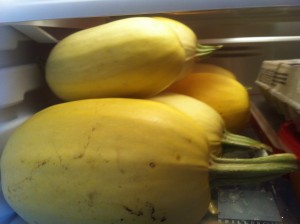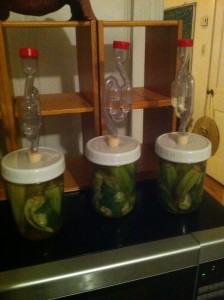It’s sad and I have to admit. I do not cook all the vegetables that I grow. Yes, it’s blasphemous. A lot of it ends up in the refrigerator to spoil or I give it away to people who may use it. Only god knows how much has ended in the compost heap or (tear) in the trash traveling wastefully to a landfill.
This season’s harvest has been good, too good. And it’s only going to get better. The fear and despair of more waste has been mounting on me for some time now. In the hopes of forgiving myself, I’ve begun a new project, fermentation. It’s already happening in the fridge with all the rotting veggies. Only now, it’s a controlled rot that is good for you and the environment. The bacteria that grows with fermenting vegetables is probiotic, good for your digestion and stores without the use of refrigeration or electricity. In many ways, this method is easier, better for your health and safer than modern canning methods (there’s the risk of botulism from improper canning of vegetables ).
To begin the venture, I did a little reading online and decided I wanted something more substantial. Being a book geek, I ordered the latest and greatest book by Sandor Katz, The Art of Fermentation. The only word that comes to mind is ‘Ahh-mazing.’ I highly recommend it along with his previous book, Wild Fermentation.
If you wish to get started now though, all you need is unchlorinated water, veggies and a container. That’s it.
- Filter/boil your water if it has chlorine. Some areas use chloramine and the info online has been all over. Some say boiling doesn’t work. Others say it does. I don’t know, but Ft Worth does use chloramine and the filtered water is working just fine.
- Karate chop your veggies: Yes literally squeeze them to death or punch them. Cooking is violent and so is pickling. (It’s good for you and for the fermenting process.) This will break open those cell walls to allow for all your spices and water to easily penetrate into your vegetables. This equals more tasty pickles.
- Add salt and spices to your satisfaction. This step is not necessary, but I believe it tastes better and makes the process go much quicker. The salt will pull out all the juices from your garden produce and create a richer environment for probiotic communities.
- Drown the Veggies.Stuff it all in your container as much as possible and pour in your water to fill the container. This will create a richer anaerobic, oxygen-less, environment. These critters don’t need oxygen and they’ll out compete the ones that do. The veggies that are exposed to air may grow some mold on it, but that’s okay. More on that later.
- Now, Put a Lid on It. You don’t want to screw the lid on too tight. Pressure will build up on the inside from build up of carbon dioxide. It’s a product from fermentation and it’s natural. If you want to get fancy you can make an airlock to prevent oxygen from getting back in. I’ve heard that it makes your veggies taste better so I opted to go this route without trying the other one.
- Wait a Week or Two or longer. Place the jar in an area that doesn’t get directsunlight. Ultraviolet rays from the sun will kill off the probiotic bacteria. From here, the job is slow and steady but it’ll taste amazing. In two weeks you can taste it for yourself and see how it is. After that it’ll store for as long as you don’t eat it.
- Continue to Experiment. Try new things and see what tastes good and what tastes best. The possibilities are endless. Some of the variables to think about are temperature, salt, light, types of vegetables, combination of vegetables, and of course your herbs and spices. Keep in mind fermenting in hotter areas will speed up the fermentation process but make your veggies more mushy. Colder temperatures will help to maintain the crunchiness of your veggies
Now for the big question, “Is it Safe to Eat?” You bet it is! Sauerkrat and many other fermented goodies all use the same or similar process. It’s been done for ages and there’s little need to worry about bad bacteria using these methods. If there’s a little mold growing on top just skim it off and everything below that is good to eat.
If you want to get fancy, you can build an airlock onto your lids to prevent as much mold on top. You can find resources here on how to make it yourself.
Now go Cultivate Your Gut.




